Vulnerability Assessment and Differentiated Regulation of Rural Settlement Systems in the Alpine Canyon Area of Western Sichuan Under Geological Hazard Coercion: Taking Maoxian County of Sichuan as an Example
Abstract
1. Introduction
2. Study Area and Data Source
2.1. Study Area
2.2. Data Sources and Preprocessing
3. Research Methods
3.1. Vulnerability Assessment of Rural Settlement Systems
3.1.1. Index System Construction
3.1.2. Evaluation Model
- ①
- Standardization of data processing
- ②
- Subjective and objective combination weighting method
3.2. Vulnerability Classification of Rural Settlement System
4. Results
4.1. Spatial Differentiation of Rural Settlement Vulnerability in Maoxian County
4.1.1. Exposure
4.1.2. Sensitivity
4.1.3. Adaptability
4.1.4. Vulnerability
4.2. Vulnerability Types Division
4.2.1. Vulnerable Areas and Vulnerability Type Division
4.2.2. Vulnerability Characteristics
4.3. Differential Regulation Countermeasures
4.3.1. General Requirements
4.3.2. Differential Regulation
5. Conclusions
- (1)
- Under geological hazard stress scenarios, the vulnerability of rural settlement systems manifests as the dynamic response state of human–land coupled systems to internal and external disturbances. This state fundamentally reflects the nonlinear feedback between disturbance intensity and recovery capacity, embodying both the spatial destruction intensity of disasters on settlements and the system’s self-organized resilience. Its core dimensions can be deconstructed into exposure sensitivity and adaptive capacity.
- (2)
- Significant spatial differentiation of vulnerability and multidimensional coupling serve as core drivers. Exposure in Maoxian’s rural settlements exhibits a distinct “east-high, west-low” spatial pattern under dual pressures of “human activity-dominated” and “natural stress-type” hazards. Sensitivity displays a “northwest-high, southeast-low” spatial differentiation, reflecting the spatial superposition of “natural baseline sensitivity” and “socioeconomic vulnerability.” Adaptability exhibits a “high in southeast, low in northwest” spatial pattern, reflecting a polarized structure dominated by “infrastructure-driven” and “public service deficit” factors. Rural settlement vulnerability in Maoxian County shows a “high in northwest–southeast, low in central” spatial distribution, resulting from the dual-core structure of “northwest disaster sensitivity” and “southeast socioeconomic pressure.” Research indicates that the core contradiction in Maoxian’s high-vulnerability zones lies in the conflict between “ecological security barrier functions” and “rural development demands”: The high-vulnerability northwest requires strict adherence to ecological protection redlines to interrupt disaster chains, yet traditional agriculture relies on steep slope cultivation, and industrial transformation lacks financial and technical support. The southeastern high-vulnerability zone relies on urbanization for economic growth, yet population and industrial concentration amplify exposure risks to geological hazards, while existing disaster prevention facilities struggle to address the chain reactions triggered by human activities and geological disasters.
- (3)
- Differentiated regulation is imperative. The vulnerability of rural settlement systems in Maoxian County is categorized into eight types: strong comprehensive vulnerability, exposure-sensitivity vulnerability, exposure-adaptation vulnerability, sensitivity-adaptation vulnerability, exposure-dominated vulnerability, sensitivity-dominated vulnerability, adaptation-dominated vulnerability, and weak comprehensive vulnerability. Following the principle of “Ecological Security Anchoring—System Graded Regulation—Chain Risk Interruption—Spatial Precision Matching,” differentiated approaches guide the reduction in vulnerability in rural settlement systems: For high-integrated vulnerability, a tripartite collaborative system is established, integrating ecological restoration, industrial structure optimization, and emergency capacity enhancement to achieve vulnerability reduction. Exposure-Sensitivity Vulnerability should reduce exposure and sensitivity through blue-green space substitution, smart early warning systems, and enhanced villager risk awareness. Exposure-Adaptation Vulnerability should cultivate adaptive capacity and resilience by constructing protective works and coordinating enterprise–township disaster response to reduce exposure. Sensitivity-Adaptation Vulnerability should lower disaster sensitivity and enhance adaptive resilience through farmland-to-forest conversion and cultural empowerment. For exposure-dominant vulnerability, agricultural structures in rural settlements should be adapted to enhance disaster resistance by designating “disaster buffer zones” and jointly building disaster prevention facilities with townships to reduce exposure. For sensitivity-dominant vulnerability, ecological sensitivity regulation and vertical spatial governance should be implemented while repatriating returning populations to mitigate aging. For adaptation-capacity-dominant vulnerability, transportation, emergency response, and educational infrastructure should be improved. For the weak comprehensive vulnerability type, preventive conservation should be implemented and cultural resilience sustained.
6. Discussion
- (1)
- Comparison with rural settlement systems in other typical regions
- (2)
- Study Limitations
- (3)
- Future Research Directions
Author Contributions
Funding
Institutional Review Board Statement
Informed Consent Statement
Data Availability Statement
Conflicts of Interest
References
- Wu, X.Y.; Zhu, C.L.; Yu, J.B.; Zhai, L.; Zhang, H.X.; Yang, K.J.; Hou, X.L. Ecological Vulnerability in the Red Soil Erosion Area of Changting under Continuous Ecological Restoration: Spatiotemporal Dynamic Evolution and Prediction. Forests 2022, 13, 2136. [Google Scholar] [CrossRef]
- Ru, S.F.; Ma, R.H. Assessment, spatial analysis and prediction of ecological environment vulnerability in the Yellow River Basin. J. Nat. Resour. 2022, 37, 1722–1734. [Google Scholar]
- Yang, L.; Wang, S. Analysis of farmers’ vulnerability and its influencing factors in poverty-stricken areas. China Popul. Resour. Environ. 2015, 25, 150–156. [Google Scholar]
- Zhong, J.T.; Ma, Y.T.; Mi, W.B.; Shi, J.L.; Jiang, X. Evaluation of livelihood vulnerability of herdsmen in Qinghai Lake National Park under multiple pressures. Econ. Geogr. 2024, 44, 169–177 + 217. [Google Scholar]
- Fang, C.; Wang, Y. Comprehensive measurement and spatial differentiation characteristics of urban vulnerability in China. J. Geogr. 2015, 70, 234–247. [Google Scholar]
- Li, Y.Y.; Wang, M.; Wang, Y.Y.; Fang, C.H.; Gou, M.H. The concept, measurement and spatial differentiation characteristics of urban spatial vulnerability-a case study of prefecture-level cities in Chengdu-Chongqing economic circle. Urban Plan. J. 2025, 69, 43–50. [Google Scholar]
- Yang, R.; Pan, Y. The spatial characteristics, formation mechanism and countermeasures of rural vulnerability in China ’s counties. Acta Geogr. Sin. 2021, 76, 1438–1454. [Google Scholar]
- Yu, T.T.; Jiang, C.Y.; Leng, H.; Yuan, Q. Rural Vulnerability Assessment for Territorial Space Governance in Rural Areas - Theoretical Thinking, Empirical Research and Application Prospect. Urban Plan. 2022, 46, 45–53 + 73. [Google Scholar]
- Peng, P.; Gu, D.; Zhou, G. The influence mechanism of vulnerability pattern change and response index of rural human settlements in Hunan Province. Econ. Geogr. 2022, 42, 168–178. [Google Scholar]
- Speranza, C.I.; Wiesmann, U.; Rist, S. An indicator framework for assessing livelihood resilience in the context of social-ecological dynamics. Glob. Environ. Change 2014, 28, 109–119. [Google Scholar] [CrossRef]
- Li, B.; Su, F.; Yang, Z.; Han, Z.L.; Guo, J.K.; Pan, H. From the perspective of vulnerability, the evolution of regional system characteristics and sustainable development model of human-sea relationship in Liaoning coastal areas. Reg. Res. Dev. 2017, 36, 32–36. [Google Scholar]
- Li, Y.; Wang, S.; Huang, H. Rural disaster vulnerability assessment and influencing factors-Taking Xunxian County, Henan Province as an example. Geogr. Sci. 2024, 44, 1818–1825. [Google Scholar]
- Tang, H.; Liu, Y.; Gu, J. Vulnerability assessment and spatial differentiation characteristics of China ’s urban economic system under the influence of population aging. Geogr. Sci. 2025, 45, 835–847. [Google Scholar]
- Ren, G.P.; Zheng, H.K.; Yin, G.; Liu, L.M. Spatio-temporal evolution characteristics of social-ecological system vulnerability and the influence of flow factors in metropolitan suburbs. Geogr. Sci. Prog. 2024, 43, 531–544. [Google Scholar]
- Li, Y.; Fang, B.; Zhang, Z. Evolution and optimal regulation of cultivated land use vulnerability in the process of urbanization-Taking Huaihai Economic Zone as an example. Resour. Environ. Yangtze River Basin 2024, 33, 2410–2424. [Google Scholar]
- Zhu, S.J.; Wu, Y.M.; Sun, J.; Ke, Y.C.; Lu, Q.P.; Liu, J.L. Spatial-temporal evolution characteristics and influencing factors of rural livelihood resilience in southwest mountainous areas from 2000 to 2020. Resour. Environ. Yangtze River Basin 2025, 34, 1371–1384. [Google Scholar]
- Li, J.; Hu, D.; Xie, M.; Zhang, Y.; Teng, L.; Chu, J.; Yin, H. Vulnerability assessment of rural settlement system from the perspective of society-ecology-a case study of Mengwa flood storage area. Ecology 2023, 43, 9164–9176. [Google Scholar]
- Li, Z.; Shi, L.; Zhang, C. Vulnerability assessment and differentiated coping strategies of county rural regional system from the perspective of society-ecology. Econ. Geogr. 2022, 42, 175–184. [Google Scholar]
- Guo, X.; Lv, Z.; Zhou, X. Holistic Governance and Rural Resilient Development: A “Four-Dimensional” Theoretical Analysis Framework. Soc. Sci. Res. 2024, 39, 13–22. [Google Scholar]
- Peng, F.; Han, Z.L.; Yang, J.; Zhong, J.Q. Research on the spatial and temporal differentiation of marine economic system vulnerability in China ’s coastal areas based on BP neural network. Resour. Sci. 2015, 37, 2441–2450. [Google Scholar]
- Ren, G.P.; Liu, L.M.; Li, H.Q.; Ji, X.; Yin, G. Optimization of rural land comprehensive improvement pattern based on improved entropy weight DEA-TOPSIS model. J. Earth Inf. Sci. 2022, 24, 280–298. [Google Scholar]
- Chen, F.; Li, Z.H.; Dong, S.C.; Rn, Y.; Li, J.N.; Rykov, P.V. Ecological vulnerability assessment of counties in hilly and gully regions of the Loess Plateau based on VSD model-A case study of Lintao County, Gansu Province. Resour. Environ. Arid Areas 2018, 32, 74–80. [Google Scholar]
- Acosta-Michlik, L.; Espaldon, V. Assessing vulnerability of selected farming communities in the Philippines based on a behavioural model of agent’ s adaptation to global environmental change. Glob. Environ. Change 2008, 18, 554–563. [Google Scholar] [CrossRef]
- Polsky, C.; Neff, R.; Yarnal, B. Building comparable global change vulnerability assessments, The vulnerability scoping diagram. Glob. Environ. Change 2007, 17, 472–485. [Google Scholar] [CrossRef]
- Turner, B.L.; Kasperson, R.E.; Matson, P.A.; McCarthy, J.J.; Corell, R.W.; Christensen, L.; Eckley, N.; Kasperson, J.X.; Luers, A.; Martello, M.L. A frame work for vulnerability analysis in sustainability science. Proc. Natl. Acad. Sci. USA 2003, 100, 8074–8079. [Google Scholar] [CrossRef]
- Huang, R. Analysis of post-disaster effect of Wenchuan earthquake. J. Eng. Geol. 2011, 19, 145–152. [Google Scholar]
- Yang, Z.; Guo, C.; Yao, X.; Du, G. Susceptibility assessment of geological disasters in the eastern margin of the Qinghai-Tibet Plateau considering post-earthquake effects. Chin. J. Geol. Disasters Prev. 2017, 28, 103–112. [Google Scholar]
- Computer Network Information Center, Chinese Academy of Sciences. Geospatial Data Cloud [EB/OL]. Available online: https://www.gscloud.cn/ (accessed on 18 September 2025).
- Tianditu. Administrative Division Visualization [EB/OL]. (May 2024). Available online: https://cloudcenter.tianditu.gov.cn/administrativeDivision (accessed on 21 September 2025).
- Li, C.; Wang, X.; He, C.; Wu, X.; Kong, Z.; Li, X. National 1:200,000 Digital Geological Map (Public Version) Spatial Database. Geol. China 2019, 46 (Suppl. S1), 1–10. [Google Scholar]
- 91 Satellite Image Assistant Official Website. 91 Satellite Image Assistant - Imagery Elevation Download Expert [EB/OL]. (May 2024). Available online: https://www.91weitu.com/ (accessed on 21 September 2025).
- Institute of Geographic Sciences and Natural Resources Research, Chinese Academy of Sciences. Resource and Environmental Science and Data Platform. Available online: https://www.resdc.cn/ (accessed on 18 September 2025).
- Didan, K. MOD13A3 MODIS/Terra Vegetation Indices Monthly L3 Global 1km SIN Grid V006 [EB/OL]. (19 August 2015). Available online: https://www.earthdata.nasa.gov/data/catalog/lpcloud-mod13a3-006 (accessed on 18 September 2025).
- Maoxian County People’s Government. Statistical Bulletin of National Economic and Social Development of Maoxian County 2023 [EB/OL]. (21 May 2024). Available online: https://www.maoxian.gov.cn/mxrmzf/c100087/202405/57946b4127da4b48924d8b8bdb59a74c.shtml (accessed on 18 September 2025).
- Maoxian Natural Resources Bureau. Overall Territorial Spatial Planning of Maoxian Tumen Green Circular Economy Zone (2021–2035) (Public Notice Version) [EB/OL]. (5 June 2024). Available online: https://www.maoxian.gov.cn/mxrmzf/c100053/202406/be5c82be9e0c46529d43c1ddd71119bf.shtml (accessed on 18 September 2025).
- Maoxian Natural Resources Bureau. Public Notice by Maoxian Natural Resources Bureau on “Overall Territorial Spatial Planning of Maoxian Goukou Ecological Governance Zone (2021–2035) (Draft for Public Comment)” [EB/OL]. (5 June 2024). Available online: https://www.maoxian.gov.cn/mxrmzf/c100053/202406/9a7e5bf7c381405b900dcd0f621a4b71.shtml (accessed on 18 September 2025).
- Maoxian Natural Resources Bureau. Public Notice by Maoxian Natural Resources Bureau on “Overall Territorial Spatial Planning of Maoxian Fengyi Industry-City Integration Zone (2021–2035) (Public Notice Draft)” [EB/OL]. (5 June 2024). Available online: https://www.maoxian.gov.cn/mxrmzf/c100053/202406/c01fac8deba24144ab1655259cd01cad.shtml (accessed on 18 September 2025).
- Maoxian Natural Resources Bureau. Public Notice by Maoxian Natural Resources Bureau on “Overall Territorial Spatial Planning of Maoxian Diexi Cultural Tourism Resort Zone (2021–2035) (Draft for Public Comment)” [EB/OL]. (5 June 2024). Available online: https://www.maoxian.gov.cn/mxrmzf/c100053/202406/b5ae4213771e4055a6b20d4701517a48.shtml (accessed on 18 September 2025).
- Maoxian Natural Resources Bureau. Public Notice by Maoxian Natural Resources Bureau on “Overall Territorial Spatial Planning of Maoxian Chibusu High-Altitude Agricultural Specialty Zone (2021-2035) (Public Comment Draft)” [EB/OL]. (5 June 2024). Available online: https://www.maoxian.gov.cn/mxrmzf/c100053/202406/a34cd1c4bdef49d88ab85a6744eea859.shtml (accessed on 18 September 2025).
- Maoxian Natural Resources Bureau. Public Notice by Maoxian Natural Resources Bureau on “Maoxian Territorial Spatial Ecological Restoration Planning (2021–2035) (Draft for Comment)” [EB/OL]. (23 February 2023). Available online: https://www.maoxian.gov.cn/mxrmzf/c100053/202302/d65fe1319fbf4daba46ddf9ea9b89204.shtml (accessed on 18 September 2025).
- Maoxian Water Affairs Bureau. Public Notice by Maoxian Water Affairs Bureau on “Maoxian 2023 Annual Water Resources Bulletin” [EB/OL]. (12 November 2024). Available online: https://www.maoxian.gov.cn/mxrmzf/c100053/202411/3746a8e597cc4a91af53989002ea5640.shtml (accessed on 18 September 2025).
- Luers, A.L. The surface of vulnerability: An analytical framework for examining environmental change. Glob. Environ. Change 2005, 15, 214–223. [Google Scholar] [CrossRef]
- Taubenböck, H.; Post, J.; Roth, A.; Zosseder, K.; Strunz, G.; Dech, S. A conceptual vulnerability and risk framework as outline to identify capabilities of remote sensing. Nat. Hazards Earth Syst. Sci. 2008, 8, 409–420. [Google Scholar] [CrossRef]
- Zhou, X.; Li, H.; Yin, J. Research on the Evolution of Vulnerability in Rural Regional Systems and Classification of Its Causes in Jilin Province. Res. Agric. Mod. 2022, 43, 679–690. [Google Scholar]
- Yang, Q.; Liu, Q.; Yin, S.; Zhang, J.; Yang, X.; Gao, Y. Vulnerability of Rural Transportation Environment and Its Influencing Factors in Qinba Mountain Area: A Case Study of Luonan County, Shaanxi Province. Acta Geogr. Sin. 2019, 74, 1236–1251. [Google Scholar]
- Wei, L.; Lu, Y. Evaluation of Rural Agglomeration and Vulnerability in Counties of Jiangsu Province. J. Geoinf. Sci. 2020, 22, 218–230. [Google Scholar]
- Huang, J.Y.; Liu, Y.; Ma, L.; Li, H.; Su, F. Review of Foreign Vulnerability Theoretical Models and Assessment Frameworks. Reg. Res. Dev. 2012, 31, 1–5 + 15. [Google Scholar]
- Xu, P.P.; Xu, J.M.; Shang, Y.W.; Ma, J.; Wang, L.F.; Qian, H. Evaluation of Water Resource Vulnerability and Influencing Factors in Southern Shaanxi Urban Agglomerations Based on the VSD Model. Res. Soil Water Conserv. 2024, 31, 319–327 + 343. [Google Scholar]
- Chen, J.; Yang, X.J.; Yin, S.; Wu, K.S. Evolution and Simulation of Socio-Ecological System Vulnerability in Semi-Arid Regions Based on the VSD Framework. Acta Geogr. Sin. 2016, 71, 1172–1188. [Google Scholar]
- Dang, E.S.; Hu, W.J.; Chen, G.L.; Ma, Z.Y.; Chen, B.; Chen, Z.Q.; Liu, W.H. Evaluation of Regional Ecological Vulnerability in the Coastal Zone of Dongshan County Based on the VSD Model. Mar. Environ. Sci. 2017, 36, 296–302. [Google Scholar]
- Zhang, M.; Luo, H.; Chen, L. Vulnerability Assessment of Resource-Based Cities: The Case of Panzhihua City. Resour. Environ. Yangtze River Basin 2018, 27, 1170–1178. [Google Scholar]
- Wu, X. Comparative analysis of three weighting methods. China ’s Collect. Econ. 2016, 32, 73–74. [Google Scholar]
- Frazier, G.T.; Thompson, M.C.; Dezzani, J.R. A framework for the development of the SERV model: A Spatially Explicit Resilience-Vulnerability model. Appl. Geogr. 2014, 51, 158–172. [Google Scholar] [CrossRef]
- Metzger, M.J.; Rounsevell, M.D.; Acosta-Michlik, L.; Leemans, R.; Schröter, D. The vulnerability of ecosystem services to land use change. Agric. Ecosyst. Environ. 2006, 114, 69–85. [Google Scholar] [CrossRef]
- Wang, C.; He, Y. Spatial-temporal differentiation and differential regulation of rural production space system vulnerability in Chongqing. Geogr. J. 2020, 75, 1680–1698. [Google Scholar]

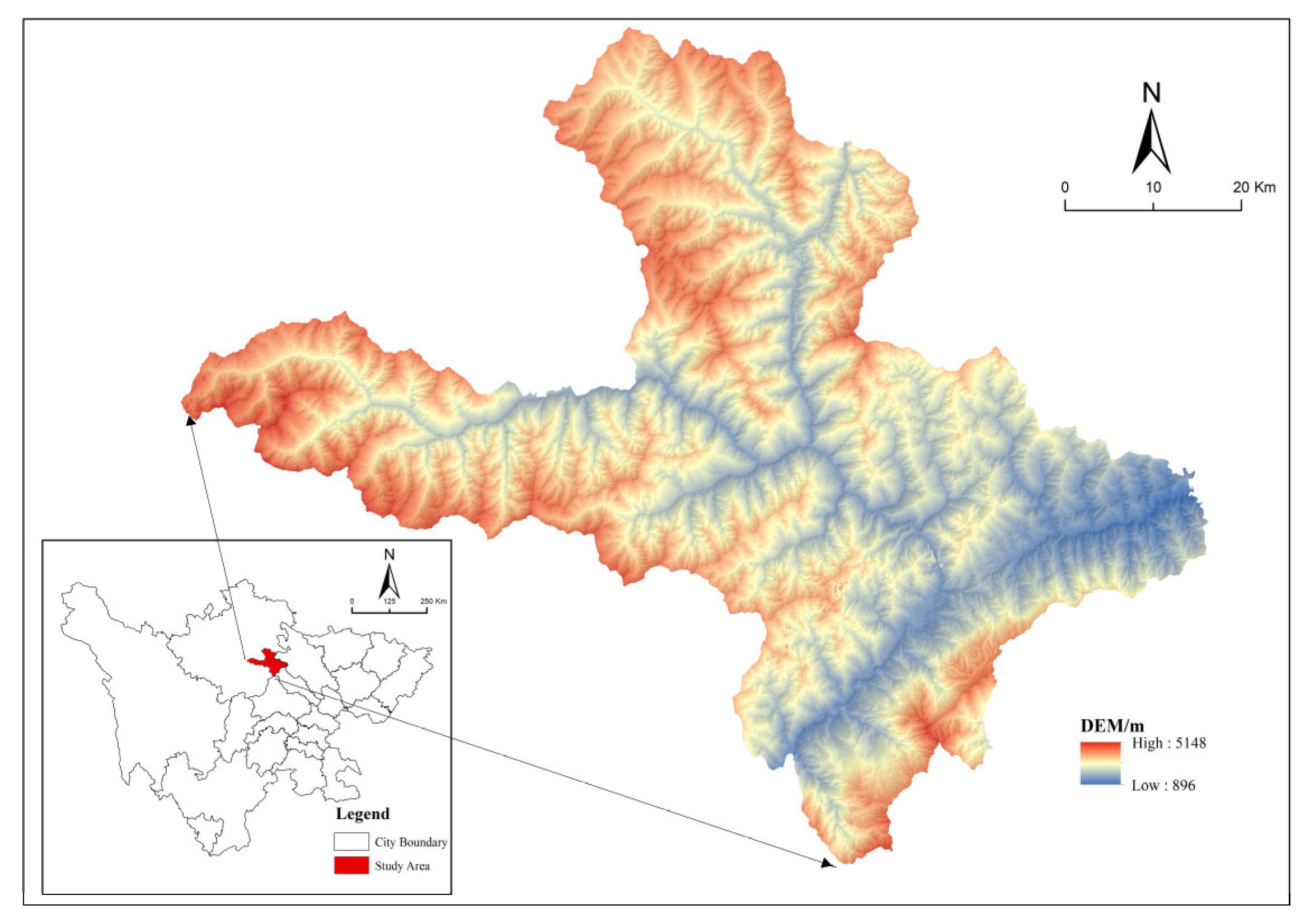
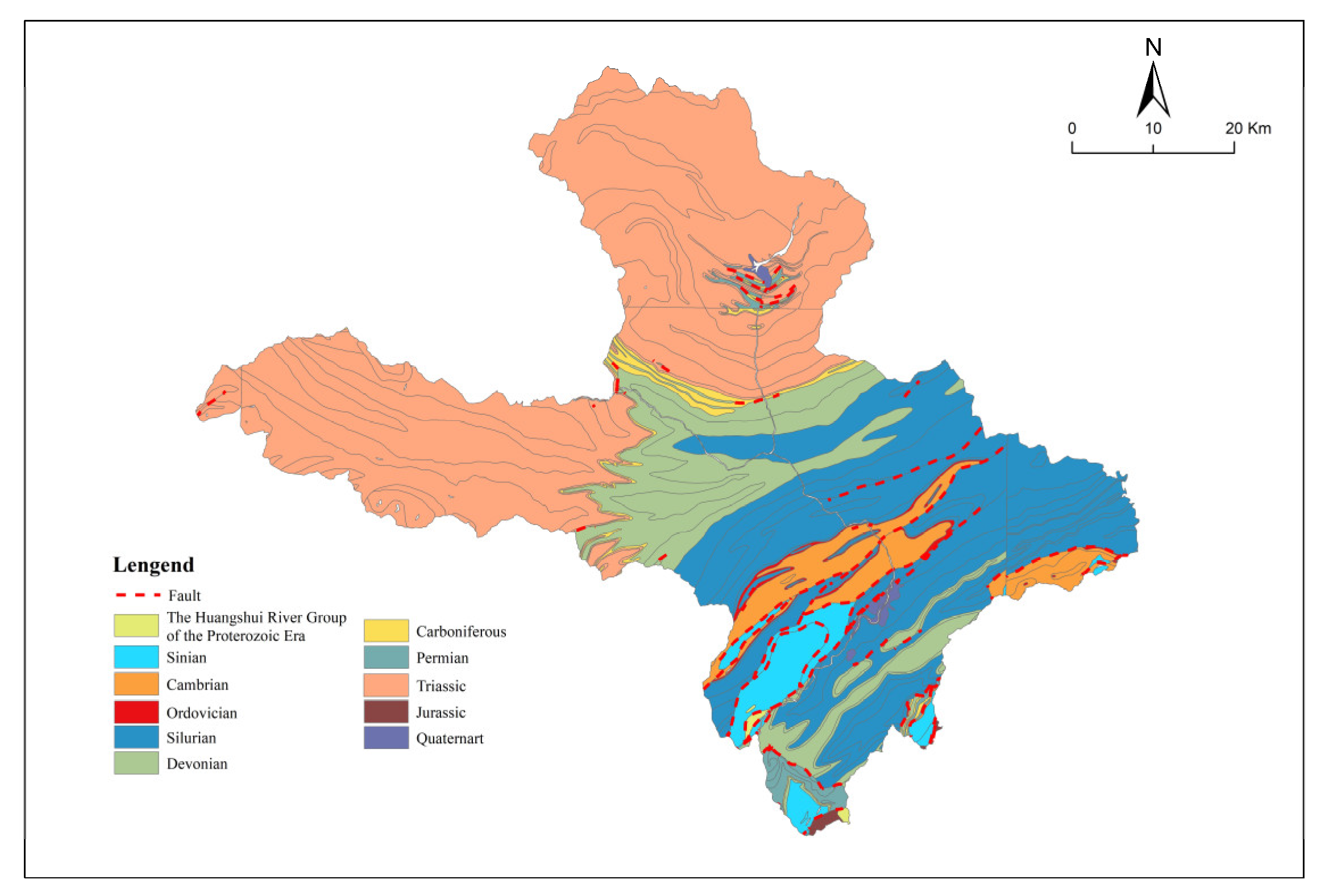

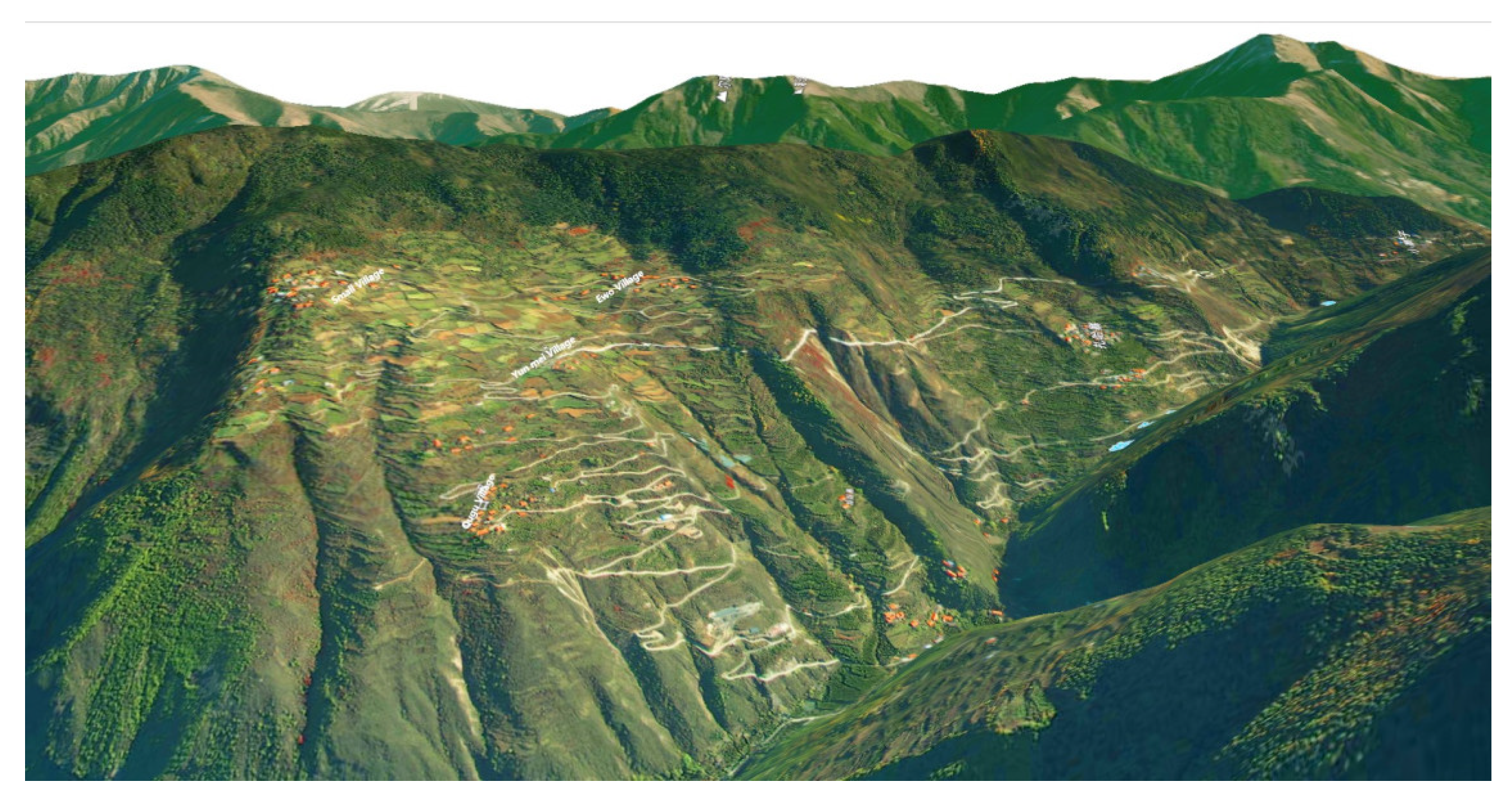
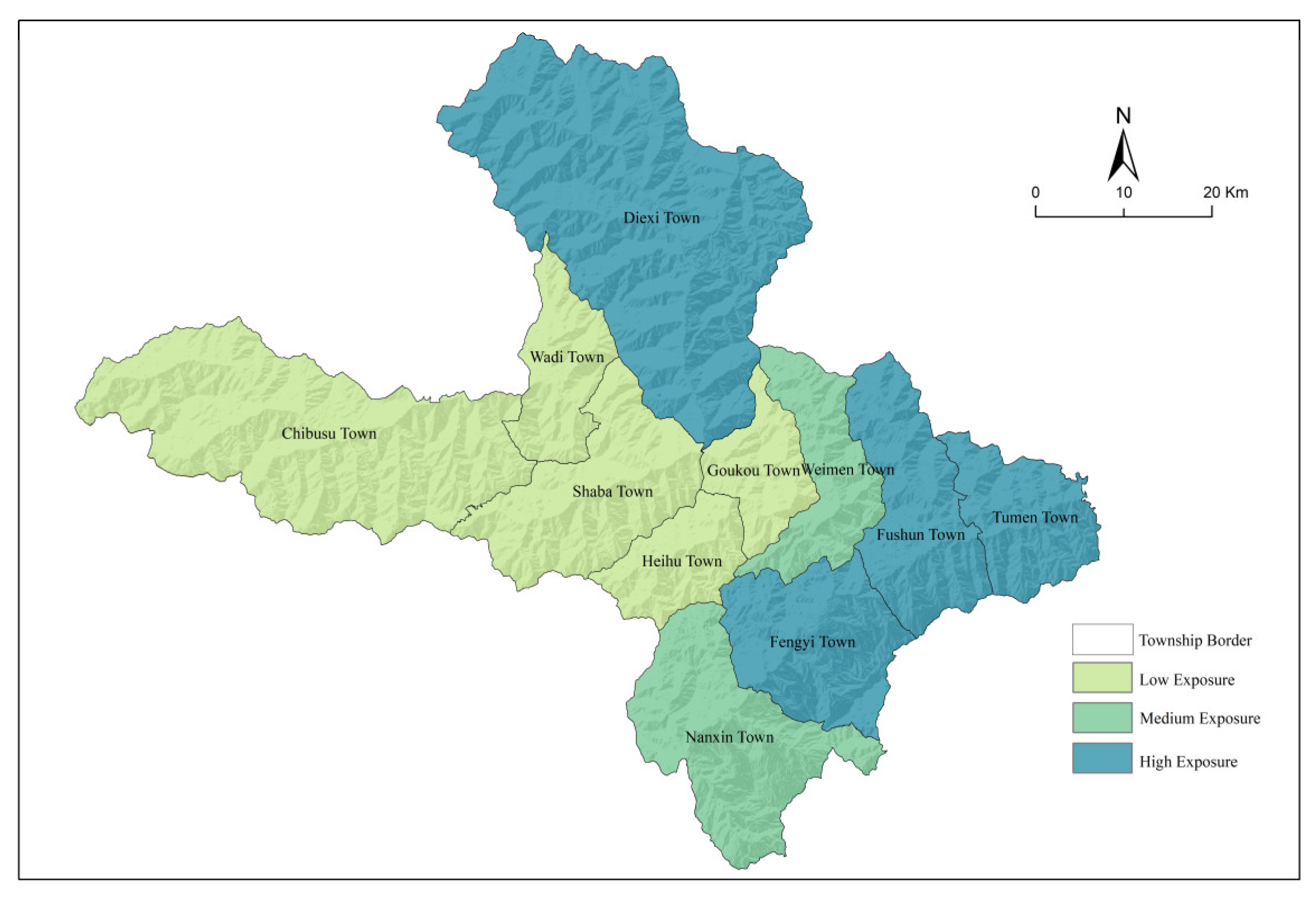


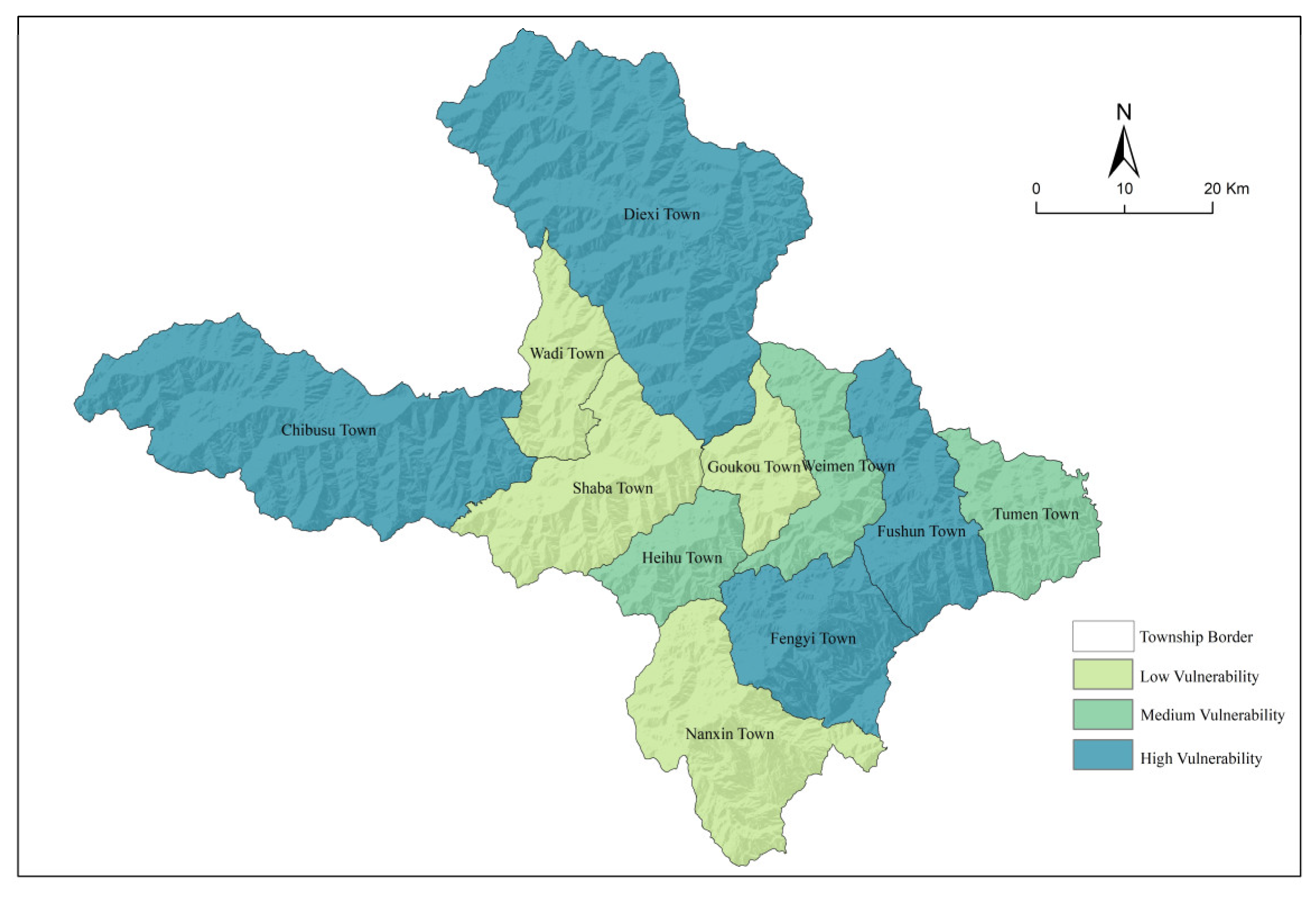

| Hazard Type | Quantity (Place) | Proportion (%) | Main Risk Characteristics |
|---|---|---|---|
| Landslide | 568 | 64.2 | It is concentrated in the steep slope transition zone, which is mostly triggered by heavy rainfall. |
| Collapse | 184 | 20.8 | Common in deep canyon rock walls |
| Debris flow | 133 | 15.0 | Mostly developed in the valleys rich in loose deposits. |
| Total | 885 | 100.0 | 28 high-risk points |
| Dimensional Layer | Element Layer | Indicator Layer | Index Content | Nature of Indicators | CRITIC Weights (Waj) | AHP Weights (Wbj) | Combination Weight (Wj) |
|---|---|---|---|---|---|---|---|
| Exposure + (0.3780) | Hydrographic condition | Precipitation | Mean annual precipitation 1 | + | 0.0319 | 0.0313 | 0.0316 |
| river system | River network density 2 | + | 0.0278 | 0.0276 | 0.0277 | ||
| Geological disaster risk | Soil erosion | Soil erosion intensity 3 | + | 0.0264 | 0.0257 | 0.0261 | |
| Geological calamity | Number of important geological disaster hidden danger points 2 | + | 0.0363 | 0.0478 | 0.0421 | ||
| Human activities | Urbanization level | Urbanization rate 1 | + | 0.0391 | 0.0534 | 0.0463 | |
| Proportion of rural settlements | The proportion of rural settlements in the total land area 2 | + | 0.0411 | 0.0552 | 0.0481 | ||
| Rural development pressure | Social stability | The proportion of low-income households and poverty- monitoring households 1 | + | 0.0424 | 0.0589 | 0.0507 | |
| Peasants to get rich | The per capita income level of farmers 1 | − | 0.0375 | 0.0386 | 0.0380 | ||
| Population density | Population distribution density 1 | + | 0.0427 | 0.0662 | 0.0544 | ||
| Sensitivity + (0.3620) | Natural background | Elevation | Mean altitude 4 | + | 0.0395 | 0.0467 | 0.0431 |
| Gradient | Mean gradient 4 | + | 0.0393 | 0.0447 | 0.0420 | ||
| Disfigurement of surface | Relief degree of land surface 4 | + | 0.0400 | 0.0428 | 0.0414 | ||
| Vegetated surface | Normalized difference vegetation index (NDVI) 5 | − | 0.0376 | 0.0331 | 0.0353 | ||
| Resource supply | Water resources | Water supply 1 | - | 0.0381 | 0.0311 | 0.0346 | |
| Cultivated land resources | Farmland areas per person 1 | + | 0.0379 | 0.0370 | 0.0374 | ||
| garden land | Garden area 2 | + | 0.0385 | 0.0350 | 0.0367 | ||
| Economic development | Highly sensitive farmland/garden plot ratio | Proportion of cultivated land 2 and garden plots in high disaster risk areas 2 | + | 0.0386 | 0.0389 | 0.0388 | |
| Industrial structure | Value added of the primary industry 1 | + | 0.0377 | 0.0292 | 0.0334 | ||
| Population | Rural labor | Proportion of rural labor force 1 | − | 0.0364 | 0.0272 | 0.0318 | |
| Age structure | Proportion of population under 15 and over 65 years of age 1 | + | 0.0340 | 0.0233 | 0.0287 | ||
| Adaptive capacity - (0.260) | Infrastructure | Traffic access | Regional road network density 2 | − | 0.0466 | 0.0583 | 0.0525 |
| People’s livelihood security | Health and medical community | Number of beds in medical institutions per 10,000 people 1 | − | 0.0456 | 0.0535 | 0.0495 | |
| Emergency shelter | The number of disaster shelters per 10,000 people 1 | − | 0.0464 | 0.0608 | 0.0536 | ||
| Social welfare | Number of beds in social welfare homes per 10,000 people 1 | − | 0.0457 | 0.0365 | 0.0411 | ||
| educational level | Number of secondary school students per 10,000 people 1 | − | 0.0461 | 0.0340 | 0.0401 |
| Grade | Exposure | Sensitivity | Adaptability | Vulnerability |
|---|---|---|---|---|
| Low-value area | ≤0.1097 | ≤0.1625 | ≤0.0625 | ≤0.1902 |
| Median-value area | 0.1097–0.1201 | 0.1625–0.1836 | 0.0625–0.0876 | 0.1902–0.2334 |
| High-value area | ≥0.1201 | ≥0.1836 | ≥0.0876 | ≥0.2334 |
| Frangibility Zoning | Vulnerability Types | Township Name | Dominant Feature |
|---|---|---|---|
| High-Vulnerability Zone | Strong Comprehensive Vulnerability | Diexi town | High exposure, high sensitivity, low adaptability |
| Exposure-Sensitivity Vulnerability | Fengyi Town | High exposure, high sensitivity | |
| Exposure-Adaptation Vulnerability | Fushun Town | High exposure, low adaptability | |
| Sensitivity-Adaptation Vulnerability | Chibusu Town | High sensitivity, low adaptability | |
| Medium-Vulnerability Zone | Exposure-Dominant Vulnerability | Tumen Town | High exposure |
| Sensitivity-Dominant Vulnerability | Weimen Town | High sensitivity | |
| Adaptability-Dominant Vulnerability | Heihu Town | Low adaptability | |
| Low-Vulnerability Zone | Weak Comprehensive Vulnerability | Goukou Town | Low exposure, low sensitivity, high adaptability |
| Sensitivity-Dominant Vulnerability | Shaba Town | High sensitivity | |
| Adaptability-Dominant Vulnerability | Wadi Town | Low adaptability | |
| Exposure-Adaptation Vulnerability | Nanxin Town | High exposure, low adaptability |
Disclaimer/Publisher’s Note: The statements, opinions and data contained in all publications are solely those of the individual author(s) and contributor(s) and not of MDPI and/or the editor(s). MDPI and/or the editor(s) disclaim responsibility for any injury to people or property resulting from any ideas, methods, instructions or products referred to in the content. |
© 2025 by the authors. Licensee MDPI, Basel, Switzerland. This article is an open access article distributed under the terms and conditions of the Creative Commons Attribution (CC BY) license (https://creativecommons.org/licenses/by/4.0/).
Share and Cite
Xi, X.; Shi, X.; Wang, T.; Wang, X.; Huang, K. Vulnerability Assessment and Differentiated Regulation of Rural Settlement Systems in the Alpine Canyon Area of Western Sichuan Under Geological Hazard Coercion: Taking Maoxian County of Sichuan as an Example. Sustainability 2025, 17, 8629. https://doi.org/10.3390/su17198629
Xi X, Shi X, Wang T, Wang X, Huang K. Vulnerability Assessment and Differentiated Regulation of Rural Settlement Systems in the Alpine Canyon Area of Western Sichuan Under Geological Hazard Coercion: Taking Maoxian County of Sichuan as an Example. Sustainability. 2025; 17(19):8629. https://doi.org/10.3390/su17198629
Chicago/Turabian StyleXi, Xin, Xiaona Shi, Tielin Wang, Xinyi Wang, and Ke Huang. 2025. "Vulnerability Assessment and Differentiated Regulation of Rural Settlement Systems in the Alpine Canyon Area of Western Sichuan Under Geological Hazard Coercion: Taking Maoxian County of Sichuan as an Example" Sustainability 17, no. 19: 8629. https://doi.org/10.3390/su17198629
APA StyleXi, X., Shi, X., Wang, T., Wang, X., & Huang, K. (2025). Vulnerability Assessment and Differentiated Regulation of Rural Settlement Systems in the Alpine Canyon Area of Western Sichuan Under Geological Hazard Coercion: Taking Maoxian County of Sichuan as an Example. Sustainability, 17(19), 8629. https://doi.org/10.3390/su17198629







